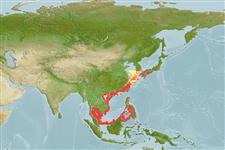Actinopterygii (ray-finned fishes) >
Scorpaeniformes (Scorpionfishes and flatheads) >
Scorpaenidae (Scorpionfishes or rockfishes) > Pteroinae
Etymology: Brachypterois: Greek, brachys, eia = short + Greek, pteryx, = fin (Ref. 45335).
Environment / Climate / Range
Ecology
Marine; demersal. Tropical, preferred ?
Northwestern Pacific: from South China Sea north to southern Japan, including the Natuna Islands, Borneo, the Gulf of Thailand, Ng Tran Bay, Vietnam and Taiwan.
Size / Weight / Age
Maturity: Lm ? range ? - ? cm
Dorsal
spines
(total): 13;
Dorsal
soft rays
(total): 10-11;
Anal
spines: 3;
Anal
soft rays: 5 - 6. This species is distinguished by the following set of characters: pectoral-fin rays 14-16 (modally 15); scale rows in longitudinal series 44-51 (47); scales above lateral line 4-6 (5); scale rows between last dorsal spine base and lateral line 4-7 (6); pre-dorsal scale rows 4-8 (5); suborbital scale rows 0-4 (2); total gill rakers 15-19 (17); head length 38.3-43.1 (mean 40.2) %SL; orbit diameter 11.1-14.5 (12.4) %SL; upper-jaw length 18.6-21.5 (20.2) %SL; length of longest dorsal-fin soft ray 18.0-23.0 (20.2) %SL; length of longest anal-fin soft ray 21.0-27.0 (23.7) %SL; caudal-fin length 30.4-44.7 (35.7) %SL; posterior lacrimal spine usually directed posteriorly, not curved upward distally; spine(s) on corner of outer angular ridge not developed, size similar to other spines on ridge, directed ventrally; spines often absent on median lateral ridge of maxilla, rarely 1-3 spines present in large adults (>80 mm SL); a large number of small spots on caudal fin, 5-26 (mean 13.3) spots on longest caudal-fin ray (Ref. 93969).
Lives in muddy habitat that are very sheltered and this is usually deep or very sheltered estuaries. Appears to be one of the more primitive forms and has similar coloration to some members of the genus Scorpaenodes, especially the markings on the head (Ref. 48635). Sometimes caught by trawl net (Ref. 559).
Life cycle and mating behavior
Maturity | Reproduction | Spawning | Eggs | Fecundity | Larvae
Matsunuma, M., M. Sakurai and H. Motomura, 2013. Revision of the Indo-West Pacific genus Brachypterois (Scorpaenidae: Pteroinae), with description of a new species from northeastern Australia. Zootaxa 3693:401-440. (Ref. 93969)
IUCN Red List Status (Ref. 115185)
CITES (Ref. 94142)
Not Evaluated
Threat to humans
Harmless
Human uses
More information
Common namesSynonymsMetabolismPredatorsEcotoxicologyReproductionMaturitySpawningFecundityEggsEgg development
ReferencesAquacultureAquaculture profileStrainsGeneticsAllele frequenciesHeritabilityDiseasesProcessingMass conversion
Tools
Special reports
Download XML
Internet sources
